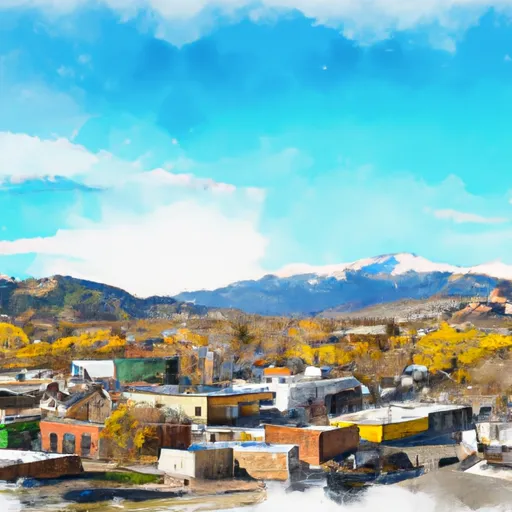-
 Snoflo Premium
Snoflo Premium
Get unlimited access to all our content
With no Ad interruptions! - Start Your Free Trial Login with existing account
Salida
Eden Index
Climate
7.2
•
Recreation
5.5
•
Community
2.7
•
Safeguard
5.5/10

Salida, Colorado is a charming town located in the heart of the Rocky Mountains. Known for its stunning natural landscapes, Salida experiences a semi-arid climate, with warm summers and cold winters. Summers are typically mild and pleasant, with average temperatures ranging from 75°F to 85°F (24°C to 29°C). Winters can be cold, with average temperatures ranging from 20°F to 40°F (-6°C to 4°C) and occasional snowfall.
Situated at the confluence of the Arkansas River and the Little Arkansas River, Salida is surrounded by abundant hydrology constituents. The Arkansas River offers thrilling river rafting and kayaking opportunities, attracting outdoor enthusiasts from around the country. Fishing is also popular, with the Arkansas River known for its excellent trout fishing.
Outdoor recreation opportunities in Salida are plentiful. The area is a paradise for hikers, mountain bikers, and rock climbers, with numerous trails and climbing spots dotting the surroundings. The nearby mountains provide ample opportunities for skiing and snowboarding during the winter months. Additionally, the town boasts a vibrant arts community, charming downtown area, and a variety of cultural events throughout the year. Salida truly offers something for everyone seeking adventure and natural beauty.
What is the Eden Index?
The Snoflo Eden Index serves as a comprehensive rating system for regions, evaluating their desirability through a holistic assessment of climate health, outdoor recreation opportunities, and natural disaster risk, acknowledging the profound impact of these factors on livability and well-being.
Climate Health Indicator (CHI): 7.2
Salida receives approximately
233mm of rain per year,
with humidity levels near 74%
and air temperatures averaging around
8°C.
Salida has a plant hardyness factor of
5, meaning
plants and agriculture in this region thrive during a short period during spring and early summer. Most
plants will die off during the colder winter months.
By considering the ideal temperature range, reliable water supplies, clean air, and stable seasonal rain or snowpacks, the Climate Health Indicator (CHI) underscores the significance of a healthy climate as the foundation for quality living.
A healthy climate is paramount for ensuring a high quality of life and livability in a region, fostering both physical well-being and environmental harmony. This can be characterized by ideal temperatures, reliable access to water supplies, clean air, and consistent seasonal rain or snowpacks.
Weather Forecast
Streamflow Conditions
Upper Arkansas
Area Rivers
Upper Arkansas
Snowpack Depths
Upper Arkansas
Reservoir Storage Capacity
Upper Arkansas
Groundwater Levels
Recreational Opportunity Index (ROI): 5.5
The Recreational Opportunity Index (ROI) recognizes the value of outdoor recreational options, such as parks, hiking trails, camping sites, and fishing spots, while acknowledging that climate plays a pivotal role in ensuring the comfort and consistency of these experiences.
Access to outdoor recreational opportunities, encompassing activities such as parks, hiking, camping, and fishing, is crucial for overall well-being, and the climate plays a pivotal role in enabling and enhancing these experiences, ensuring that individuals can engage in nature-based activities comfortably and consistently.
Camping Areas
| Campground | Campsites | Reservations | Toilets | Showers | Elevation |
|---|---|---|---|---|---|
| Buffalo Springs | 18 | 9,187 ft | |||
| Railroad Bridge - Arkansas Headwaters State Rec Area | None | 8,039 ft | |||
| Weston Pass | 14 | 10,277 ft | |||
| Cascade | 22 | 9,033 ft | |||
| Hecla Junction - Arkansas Headwaters State Rec Area | None | 7,415 ft | |||
| Rincon - Arkansas Headwaters State Rec Area | 10 | 6,788 ft | |||
| Angel of Shavano | 20 | 9,147 ft | |||
| Mount Princeton | 19 | 8,618 ft | |||
| Ruby Mountain - Arkansas Headwaters State Rec Area | None | 7,651 ft | |||
| Chalk Lake | 19 | 8,743 ft |
Nearby Ski Areas
Catastrophe Safeguard Index (CSI):
The Catastrophe Safeguard Index (CSI) recognizes that natural disaster risk, encompassing floods, fires, hurricanes, and tornadoes, can drastically affect safety and the overall appeal of an area.
The level of natural disaster risk in a region significantly affects safety and the overall livability, with climate change amplifying these risks by potentially increasing the frequency and intensity of events like floods, fires, hurricanes, and tornadoes, thereby posing substantial challenges to community resilience and well-being.
Community Resilience Indicator (CRI): 2.7
The Community Resilience Indicator (CRI) recognizes that education, healthcare, and socioeconomics are crucial to the well-being of a region. The CRI acknowledges the profound impact of these elements on residents' overall quality of life. By evaluating educational resources, healthcare accessibility, and economic inclusivity, the index captures the essential aspects that contribute to a thriving community, fostering resident satisfaction, equity, and social cohesion.

